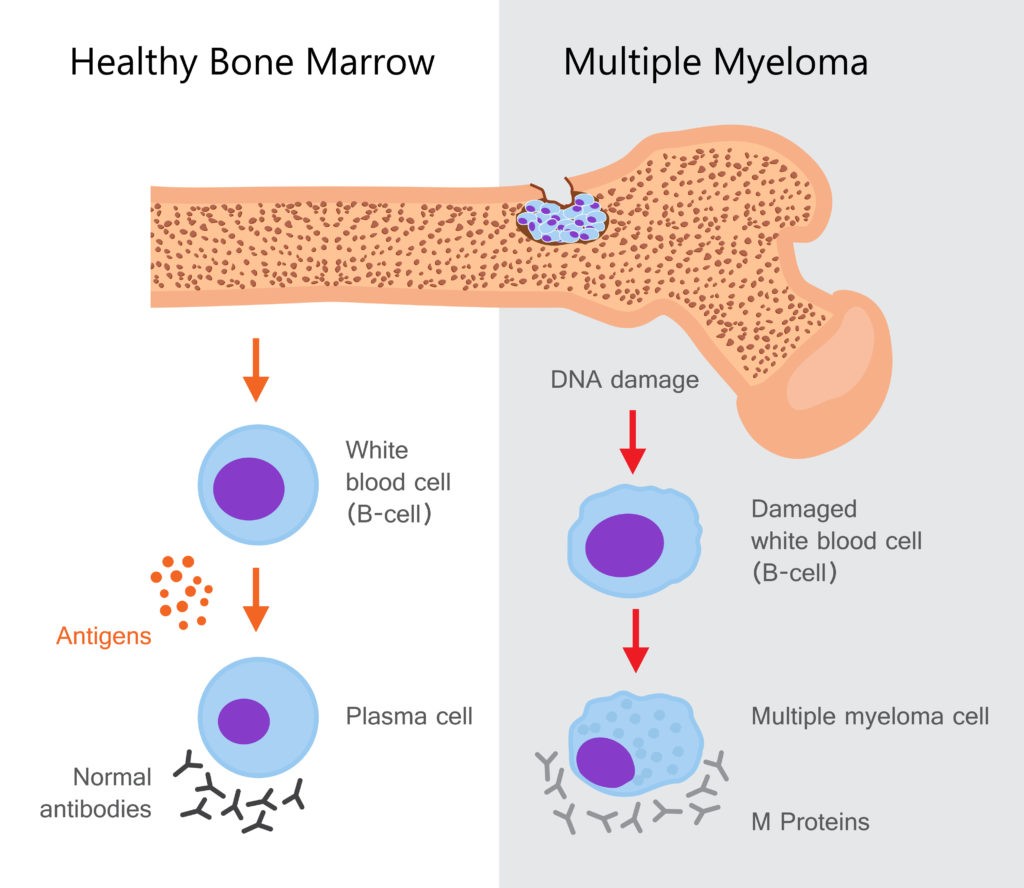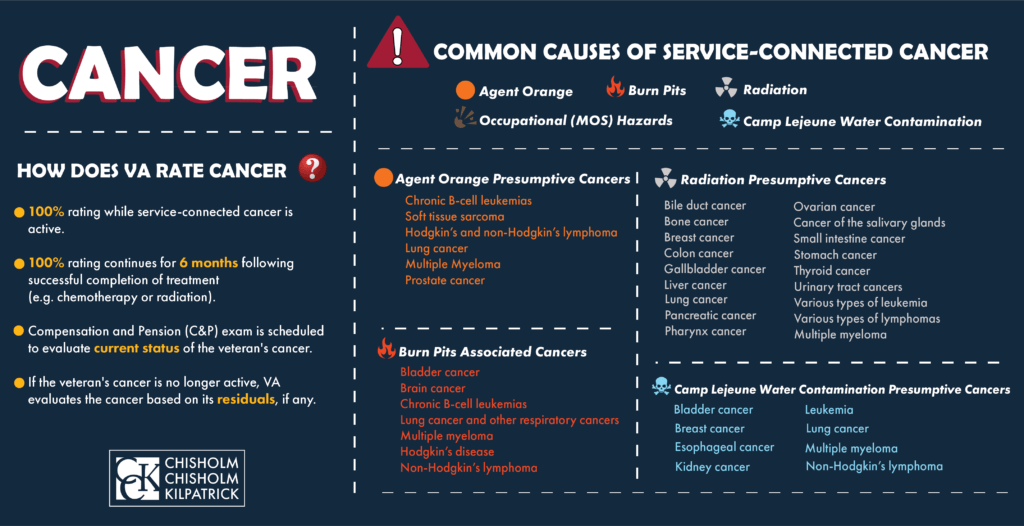VA Disability Ratings for Multiple Myeloma

CCK Law: Our Vital Role in Veterans Law
What is Multiple Myeloma?
Multiple myeloma is a form of cancer found in the plasma cells of the body. Typically, plasma cells are in the bone marrow and work as part of the immune system to fight diseases and infections. Lymphocytes are white blood cells found in the immune system. There are two forms of lymphocytes: T cells and B cells. When B cells respond to an infection or a disease, they will mature and transform into plasma cells. The plasma cells can attack then germs.
When plasma cells grow out of control, they become cancerous and are referred to as multiple myeloma. There are several plasma cell disorders that involve abnormal plasma cells, but are not classified as active multiple myeloma, such as the following:
- Monoclonal gammopathy of uncertain significance, or MGUS
- Smoldering multiple myeloma, or SMM
- Solitary plasmacytoma
- Light chain amyloidosis
Side Effects and Symptoms of Multiple Myeloma
- Low blood count—As plasma cells overgrow with multiple myeloma, they can affect the formation of normal blood-forming cells. This can ultimately lead to low blood count. Low blood count can cause anemia, or a shortage of red blood cells, which may lead to feelings of weakness and fatigue. Multiple myeloma may also cause the level of platelets in the blood to drop, resulting in bleeding and bruising, or a shortage of normal white blood cells which can result in difficulties fighting infection.
- Bone and calcium problems—Osteoclasts are cells that break down old bones in the body, while osteoblasts are cells that form new bones. Myeloma cells are part of the process that causes osteoclasts to increase the speed at which bones are dissolved. The increase in the breakdown of bones may make the bones weak and raise calcium levels in the blood.
- Infections—Plasma cells are responsible for defending the body from infection and disease by attacking germs. Abnormal plasma cells, however, cannot do this. With multiple myeloma, normal plasma cells are crowded out by abnormal cells, preventing antibodies from being made. Antibodies made by myeloma cells cannot help fight infection.
- Kidney Problems—The antibodies that are formed by myeloma cells can be harmful to the kidneys and may lead to kidney damage or failure.
Diagnosing and Treating Multiple Myeloma
Multiple myeloma can be difficult to detect early as symptoms are often not apparent until it has reached an advanced stage. The symptoms may also be vague and could take the appearance of other diseases at first. In order to diagnose multiple myeloma definitively, tests will usually need to be performed. Some tests may include:
- Complete blood count tests
- Blood chemistry tests
- Urine tests
- Quantitative immunoglobins test
- Electrophoresis
- Serum free light chains
- Beta-2 microglobulin
Biopsies may also be performed to diagnose multiple myeloma. To do this, a doctor may biopsy bone marrow or tissue. Imaging tests, like x-rays and CT scans, can also be helpful to diagnose multiple myeloma.
There are multiple forms of treatment that may be used to treat multiple myeloma. Treatments may include:
- Surgery
- Radiation Therapy
- Drug Therapy
- Stem Cell Transplant
- CAR T-cell Therapy
Additionally, there are doctors who specialize in treating multiple myeloma. Specialists who treat multiple myeloma could include orthopedic surgeons, radiation oncologists, medical oncologists, or bone marrow transplant specialists.

Compensation and Pension (C&P) Exams for Multiple Myeloma
If a veteran files a claim for VA disability benefits, VA will often request a Compensation and Pension exam, or C&P exam, to physically examine the veteran. This may occur when a veteran files a claim for multiple myeloma.
To request an exam, VA may send the veteran a letter or call them. It is very important to ensure that VA has the most up-to-date contact information, so that the veteran does not miss any exam requests. Additionally, it is also important to follow through with scheduling this exam, and to attend, otherwise VA could deny the veteran’s claim.
The exam will usually be performed by a VA physician or a VA contracted physician. Before the exam, the examiner will review the veteran’s c-file. This will contain any documentation that has previously been submitted to VA, including the veteran’s medical and service records.
The veteran may also use a DBQ, or Disability Benefits Questionnaire, to bolster their claim. A Disability Benefits Questionnaire is a form VA created to allow veterans to address important aspects of their condition, such as symptoms, severity, possible causes, and relation to other disabilities. The veteran may also have their private doctor fill out a DBQ for them. In claims for multiple myeloma, DBQs can be helpful because a specialist, such as the ones listed previously, who treats the veteran for their multiple myeloma can speak to the condition in greater detail.
VA Disability Ratings for Multiple Myeloma
Multiple myeloma is rated under 38 CFR § 4.117, Schedule of ratings – Hemic and Lymphatic Systems, diagnostic code 7112.
When a veteran has a service-connected active cancer, the VA typically assigns a 100 percent disability rating. This rating remains in effect as long as the cancer is active and continues for six months after successful completion of treatment like chemotherapy, radiation, or surgery.
After this six-month period, the VA schedules a Compensation & Pension (C&P) examination to assess the current status of the condition. If the examination shows that the cancer is no longer active but in remission, the VA evaluates the condition based on any remaining symptoms or consequences.
For example, prostate cancer may lead to issues like erectile dysfunction and urinary incontinence, which are assessed separately if present, and the disability rating may be adjusted accordingly.”
Toxic Exposure and Multiple Myeloma
Different forms of exposure have been linked to multiple myeloma in veterans who served in varying locations and time periods. Specifically, multiple myeloma has been linked to exposure to Agent Orange and military burn pits.
Agent Orange Exposure and Multiple Myeloma
Veterans who were exposed to Agent Orange and developed multiple myeloma, are entitled to the presumption of service connection described, so long as they can prove they served in qualifying locations and time periods. Specifically, such veterans do not have to prove a connection between their multiple myeloma and military service to be eligible to receive VA health care and disability compensation.
In regard to Agent Orange exposure, VA has established a presumption of exposure for the following locations and time periods:
- Vietnam between January 9, 1962 and May 7, 1975 – this only includes veterans who were boots-on-the-ground in Vietnam, or veterans with service aboard a ship that operated in the inland waterways of Vietnam, made visits ashore, and Blue Water Navy veterans.
- In or near the Korean demilitarized zone (DMZ) between September 1, 1967 and August 31, 1971.
Importantly, a presumption of exposure replaces the element of service connection that requires veterans to have an in-service event or symptoms that caused their disability. In these instances, VA counts the exposure as the in-service event. In addition to a presumption of exposure, VA also offers a presumption of service connection in which it presumes a veteran’s condition was caused by their military service. Here, VA presumes that certain diseases are caused by a veteran’s exposure to Agent Orange, with multiple myeloma being one of them.

Military Burn Pit Exposure and Multiple Myeloma
Military burn pits are large areas of land in which the military and its contractors incinerated all waste generated by military bases, including plastics, medical waste, rubber, human waste, and more.
The U.S. Military used burn pits as part of their waste disposal protocol in places such as Iraq and Afghanistan in the post-9/11 era during Operations Iraqi and Enduring Freedom. While the practice was effective in reducing large quantities of waste, burn pits emitted plumes of toxic smoke. This was especially problematic in places such as the Middle East where the desert wind carried the smoke for miles.
Many U.S. Military veterans have suffered health consequences from burn pit exposure. Most of the negative effects involve temporary ailments of the respiratory system, though limited evidence suggests a link between burn pit exposure and the long-term deterioration of lung health.
These burn pits were used extensively throughout the Middle East and have affected veterans who served in Operation Iraqi Freedom, Operation Enduring Freedom, and Operation New Dawn.
Research continues to be done to link burn pit exposure to a variety of different conditions, such as cancers and respiratory conditions. To fully understand the harm caused by military burn pits, further research will need to be done. However, research has indicated that one of the known chemical compounds released by burn pits includes the dioxin called TCDD which was also found in Agent Orange.
While VA does acknowledge certain conditions as being eligible for presumptive service connection if the veteran can prove exposure to Agent Orange, VA has not established a presumption for veterans exposed to burn pits. Since there is no presumption, VA adjudicates burn pit claims on a case-by-case basis.
VA does not have a consistent approach to deciding these claims, so lay evidence from veterans is key to winning burn pits claims. Often, statements from veterans themselves or buddy statements from fellow servicemembers can help prove exposure to VA.

New Proposed Burn Pit Legislation 2021
As of 2021, there are several major bills currently pending in Congress, that deal with the toxic exposure caused by burn pits. These bills include:
- Conceding Our Veterans’ Exposure Now and Necessitating Training Act (COVENANT)
- Presumptive Benefits for War Fighters Exposed to Burn Pits and Other Toxins Act of 2021
- Veterans Burn Pit Exposure Recognition Act
- Toxic Exposure in the American Military Act (TEAM)
Any of these bills, if passed, would offer needed relief to veterans suffering the toxic effects of burn pit exposure.
Denied VA Disability Benefits for Multiple Myeloma?
Multiple myeloma can be a confusing and frustrating condition to be granted VA disability benefits for, as it is eligible for presumptive service connection for Agent Orange exposure, but not military burn pit exposure. Therefore, these claims are often denied. However, a denial does not mean the end of the road.
The experienced team of accredited VA disability attorneys at CCK may be able to help you secure VA disability benefits for multiple myeloma. Contact our office today for a free consultation at 800-544-9144.
About the Author
Share this Post


